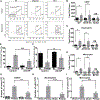A Mast-Cell-Specific Receptor Mediates Neurogenic Inflammation and Pain
- PMID: 30686732
- PMCID: PMC6462816
- DOI: 10.1016/j.neuron.2019.01.012
A Mast-Cell-Specific Receptor Mediates Neurogenic Inflammation and Pain
Abstract
Mast cells can be found in close proximity to peripheral nerve endings where, upon activation, they release a broad range of pro-inflammatory cytokines and chemokines. However, the precise mechanism underlying this so-called neurogenic inflammation and associated pain has remained elusive. Here we report that the mast-cell-specific receptor Mrgprb2 mediates inflammatory mechanical and thermal hyperalgesia and is required for recruitment of innate immune cells at the injury site. We also found that the neuropeptide substance P (SP), an endogenous agonist of Mrgprb2, facilitates immune cells' migration via Mrgprb2. Furthermore, SP activation of the human mast cell led to the release of multiple pro-inflammatory cytokines and chemokines via the human homolog MRGPRX2. Surprisingly, the SP-mediated inflammatory responses were independent of its canonical receptor, neurokinin-1 receptor (NK-1R). These results identify Mrgprb2/X2 as an important neuroimmune modulator and a potential target for treating inflammatory pain.
Copyright © 2019 Elsevier Inc. All rights reserved.
Conflict of interest statement
DECLARATION OF INTERESTS
The authors declare no competing interest.
Figures




Comment in
-
Substance P and Inflammatory Pain: Getting It Wrong and Right Simultaneously.Neuron. 2019 Feb 6;101(3):353-355. doi: 10.1016/j.neuron.2019.01.034. Neuron. 2019. PMID: 30731054
References
Publication types
MeSH terms
Substances
Grants and funding
LinkOut - more resources
Full Text Sources
Other Literature Sources
Molecular Biology Databases

